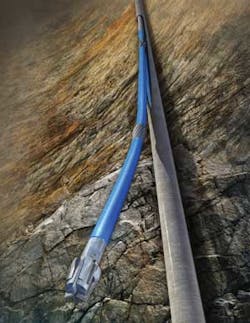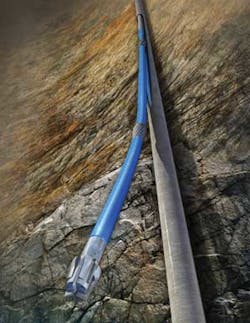One-trip casing exit milling saves time during complex drilling
Scott Trahan
Brent Fendley
Brian Magnus
Baker Hughes
Deepwater side track drilling is challenging. The trajectory of an extended-reach wellbore can change rapidly, and milling and drilling the side track is necessary for lateral drilling to reach the target in a horizontal well.
Lateral drilling requires an opening in the well casing, or a casing window. There are two ways to do this: section milling and window milling. Section milling involves milling away the complete circumference of a section of the wellbore casing or liner at a predetermined well depth. Window milling is the more economical of the two and can be completed using milling bottomhole assemblies (BHAs) in conjunction with whipstock system equipment. Its advantage over section milling is that less cutting debris needs to be circulated out of the well.
The need for a larger casing window
Performing a casing exit to create a secondary wellbore involves a whipstock assembly to direct the mill toward the side of the existing casing, where an exit is then milled. However, today's wellbore requires advanced drilling assemblies with a range of technologies, including electronics and measuring devices that send data back to the operator. Drilling assemblies have necessarily gotten larger to accommodate these additional tools.
That can present problems in side tracking a well, since the window must be large enough to allow the more complex equipment to pass through. If the window is not large enough, it will be necessary to pull out and re-work it, costing time and money. Drilling operators have found it challenging to create a window large enough for their drilling assembly to pass through in an efficient and economical manner.
In addition to the size of the drilling assemblies, the length is an issue. The primary reason to use a long drilling assembly is that it allows the driller to guarantee a certain level of straightness to the bore. However, the length of the drilling assembly often combines with the stabilizer to make it extremely stiff, which in turn makes it very difficult to pass through a standard length window.
Creating a clean, large-size window usually requires multiple trips. On average, three to four trips are needed to completely clean the window. A newly developed casing exit milling system reduces this time by typically milling the window in one trip.
A one-trip casing exit milling system
The need for effective tools to address the size, length, and stiffness of newer drilling assemblies led Baker Hughes to develop the LongBow casing exit milling system. Because the cutting structure provides a cleaner window the first time out, the system saves rig time as well.
Milling a casing exit is not only critical, but also can be time-consuming due to the need to drill ratholes before drilling the new formation. This extra trip can take up to two days of rig time. The new milling system shortens milling time for both the window and rathole. Window milling usually can be done in one trip and at the same time create a longer window with minimal window damage during milling.
The system has been in development for five years and was designed for longer drilling assemblies. It has a low-dogleg window profile, allowing low-drag access through the milled window profile for complex completions and stiff rotary-steerable BHAs.
Lessons learned from previous casing exit milling were integrated into the new system. Drillstring dynamics finite element analysis software (FEA) helped create the milling BHA. This software makes it possible to identify and reduce high operational bending stresses to optimize the length and profile of the system, as well as to increase its fatigue life. Engineered profiles and placements of the BHA's bladed cutting sections distribute restraining forces, enabling a full-gauge casing exit window.
The system uses milling technology with an improved carbide cutting structure for a cleaner window and better wear characteristics. This means less weight on the bit and less torque needed to cut efficiently.
It also features engineered milling profiles and flex areas. They work together to provide constraining forces on the window mill during milling operations to help produce straight, full-length window profiles. The system delivers flex forces on the watermelon mills, lifting the mills away from the top of the whipstock to create an elongated window profile with full-width sections.
The casing exit milling system works in both directional and vertical wells, and uses a full-drift milling profile that requires shorter rathole drilling to accommodate full-gauge drilling BHAs. It is principally designed for deep, complex well geometries and side tracking where stiff drilling and completion BHAs require low-drag access.
Case study: Brunei
The one-trip casing exit milling system was recently tested during an offshore drilling operation in Brunei. The drilling operator planned to drill a casing exit. The well was of intermediate depth, descending about 3,000 ft (914 m) to the top of the window. The primary challenge was the use of a 40-m (131-ft) drilling assembly, which was long and stiff, and needed a large, full-gauge window to accommodate the equipment.
In the past, the operator had made numerous attempts to use standard milling equipment for the casing exit; however, it had always taken multiple trips to get the window long enough for the drilling assemblies to pass through. They wanted to try out the new milling system to address the stiff drilling assembly and window size.
Although there are often many variables involved, drilling a large casing exit usually takes multiple trips. It can be a long process to get the window straightened out; with an investment of 12 to 18 hours to make each downhole trip, it is important to succeed. If the window ultimately cannot be used, it can cost the operator time and money. Costs can reach to $500,000 per day for deepwater and ultra-deepwater wells, so time on the job is a major consideration.
In the Brunei project, the angle at the kick off point for setting the whipstock was 28°. Oil-based mud was used for milling fluid. The bottom trip anchor was set and sheared out, making adjustments to the oil-based mud for carrying the metal shavings out of the hole.
The casing exit operation was performed using an extra-long WindowMaster G2 XL whipstock assembly along with the milling assembly. The casing was 95⁄8-in. outside diameter (OD) and 43.50 lbs. The casing drift was 8½-in. OD. The PathMAKER window mill was 8½-in. OD, as was the upper watermelon mill, for a full drift window. The LongBow (full-gauge mills) milling system coupled with the XL whipstock is designed to cut a straight, full-length window.
During milling, once the mill cut out the window, there was no drag coming out of the window, which indicated that the window was clean. The upper watermelon mill at the bottom of the window reciprocated and cleaned back and forth across the window several times, from 1,423 m to 1,430 m (4,669 ft to 4,692 ft), and it was possible to slide the mill across the window without any problems whether the pumps were shut on or shut off. A combination of circulation, tension, and slack-off weight ensured that the milling system passed through the window easily. Then an additional 30 m (98 ft) of rathole was drilled.
After the window was milled, rathole completed, and cleanliness was ensured, the operator ran an 8½-in. PDC bit with its complex BHA as planned to continue with the drilling operation.
It took nine hours to mill 6 m (20 ft) for the window and six hours to drill the 30 m of rathole. At the average rate of penetration, that equals 2.1 ft/hour on the window milling and 10 ft/hour on the rathole. This saved the operator between 24-30 hours of rig time. The cost of operating this rig was $375,000 per day.
Conclusion
Good casing exits are crucial to reaching previously uneconomical reserves and bypassing trouble. However, the process of cutting a window can be time-consuming, especially in complex environments with the newer BHAs, which come equipped with a wide range of technology to bring data to the surface. Multiple trips are often necessary to ensure that the window exit is clean and large enough for the drilling equipment to pass through.
With its low-dogleg window profile and one-trip milling, this system helped reduce rig time during the Brunei project by a full day, providing cost savings. The well was intermediate in depth but had a long BHA, which indicates that the milling system should be well-suited for deep, complex well geometries, and is beneficial for side tracking where stiff drilling and completion BHAs require low drag access.
In addition to creating a large casing exit window profile, this milling system provides higher-contact forces on a milling BHA, preventing early whipstock ramp departure and providing a straight-window profile with maximized full-width section.
Although results may vary in different operating environments, the Brunei project is fairly typical, with a one day reduction in operating time, offering a significant cost savings to the drilling company.


